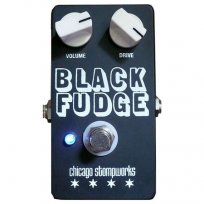After covering in-depth reinterpretations of the most popular vintage fuzz circuits (Dallas Arbiter Fuzz Face, Sola Sound Tone Bender, Electro Harmonix Big Muff, and Univox Super Fuzz), we shift our focus on a legendary device that had a crucial role in the history of fuzz… the Maestro FZ-1 Fuzz Tone.

List updated on May 15, 2023
The Original Maestro FZ-1 Fuzz Tone
Check eBay or Reverb.com for a rare original Maestro FZ-1
It’s not quite right to call the Maestro FZ-1 “lesser-known,” because it was the fuzz that started it all: the first widely marketed fuzz effect in the world. It was introduced in 1962 but didn’t gain notoriety until 1965, when Keith Richards made history by using the FZ-1 for the eternal “(I Can’t Get No) Satisfaction” riff. He actually used it as a placeholder – intending a horn line to go there!
But luckily the fuzz track remained and suddenly every rock band in the UK and the US wanted to get their hands on a fuzz box. Soon the Fuzz Face and Tone Bender pedals would emerge, and fuzz claimed its place atop the pantheon of guitar effects, thanks to the Maestro FZ-1 Fuzz Tone.
Best Maestro FZ-1 Fuzz Tone Clones/Evolutions
The sound of the FZ-1 has been inspiring many pedal builders, boutique ones in particular. With the vintage unit selling for over $600, many of them saw an opportunity in recreating authentic clones at a fraction of the cost, while others tried to improve the original, notoriously lacking in bass and finicky when interacting with other effects.
Here’s a list of our favorite Maestro FZ-1 clones and evolutions. Click on the pedals’ pictures for a demo!
1. Maestro FZ-M

$149 | Click title for video. Buy it new on Sweetwater, Thomann, or look for deals on Reverb.
A 2022 relaunch of the original with an added Modern mode and a Tone control for more flexibility. Classic mode replicates the vintage unit’s goodness, while Modern delivers a thicker, meatier tone that better suites the contemporary guitarist while offering a wider sonic palette. Just like in the original, the Attack knob controls the amount of fuzz and the Volume one the output – which in this version can go beyond unity gain if desired.
2. All Pedal Love Machine
A hand-made evolution of the vintage Maestro Fuzz-Tone FZ-1 by a quality emerging US builder. It introduces a blendable octave-up not found in the original. Another new feature of this pedal is an EQ toggle switch, placed in the center of the case, that integrates the Tone knob by pushing the mids to give your tone even more edge.
3. Basic Audio Gnarly Fuzz
Fuzz guru John Lyons’ versatile take on the FZ-1 circuit uses silicon instead of germanium transistors for more stability, but the Gnarly still sounds remarkably authentic. The added texture blend knob dials between the first and second transistor stages, allowing the user to achieve snarling octave-up tones.
4. Reuss Vintage Three Volt Fuzz
Just like the original Maestro FZ-1, the Reuss version runs on just 3 volts! The limited bandwidth of the GC301 Germanium transistors makes for a nasal, gated fuzz tone perfectly emblematic of the early fuzzes of the 1960s. It runs on two AAA batteries, which means that you can’t daisy chain it.
5. Blackstrap Electric Binx FZ-1
Beautifully hand-wired on a perf board, the Binx is a recent model that’s not trying to be modern in any way. Instead, it aims to perfectly recreate the effect it is based on, tuned against builder Matt Seppi’s personal FZ-1s. Vintage and NOS components in a 60s-style wedge enclosure.
6. Bigfoot FX Spaghetti Western Fuzz

$130 | Click title for video. Check for availability on Reverb.
Think surf. Think classic Hollywood, Ennio Moriconne. The affordable Spaghetti Western Fuzz has just two knobs and will give you that buzzy, lo-fi fuzz guitar you can hear on classic records like “Walk on By” by Isaac Hayes.
7. Mozztronics FZ-1 Classic Fuzz

$145 | Click title for video. Check for availability on Reverb.
Australian boutique maker Mozztronics specializes in studio-quality effects. Their FZ-1 Classic Fuzz adds a tone knob and a contour switch to the original circuit for lots of versatility. The Classic Fuzz will clean up elegantly with the knob on your guitar, turning into a legit-sounding overdrive at lower volumes.
8. DOD Carcosa

$124 | Click title for video. Buy it new on Sweetwater, Thomann or Amazon or look for deals on Reverb.
A popular fuzz inspired by the dual-voiced evolution of the FZ-1 (released in the early ’70s and named FZ-1S), this is a modern, silicon fuzz that can do a lot more than the other pedals on this list, thanks to a more elaborate set of controls including a high-cut filter, “before” and “after” gain stages to adjust grit and definition, and two modes: Hali for classic FZ-1-style fuzz and Dehme, for a more complex and full voice optimal for high headroom clean amps.
Other Maestro FZ-1 Clones and Evolutions
Here’s a list of other fuzzes currently available inspired by the Maestro FZ-1 Fuzz Tone.
































2 comments
Bob Olson says:
Aug 19, 2021
You guys really need to include Blammo! Electronics in your reviews. I have purchased multiple pedals from Dan and his company is beginning to boom! Super high quality affordable and stylish. FYI
JS says:
Jun 27, 2022
Please consider adding Jimmy Behan’s Super Electric Maestro FZ-1A to this list. Thanks.